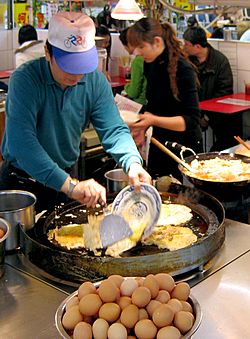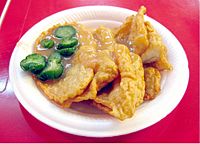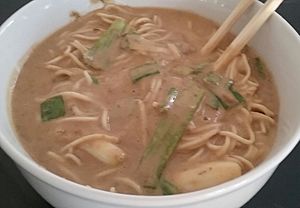Xiaochi facts for kids

|
|
| Type | Street food, snack |
|---|---|
| Place of origin | Greater China, Southeast Asia, and other places with ethnically Chinese populations |
Xiaochi (Chinese: 小吃; pinyin: xiǎochī; Wade–Giles: hsiao3ch'ih1; literally "small eats") are a special kind of Chinese street food. You can find them in many places where people of Han Chinese background live around the world. Xiaochi are like tasty snacks that can be eaten alone as a light meal. They are also great to share with friends, similar to Spanish tapas.
These snacks are usually not made at home. You also won't find them on the menus of fancy restaurants. Instead, xiaochi are sold by vendors in markets. They are also found in small shops that focus on just a few types of these delicious treats. Night markets are especially famous for their unique xiaochi items. Here, you can either take your food to go or sometimes sit at small tables. A food expert named Shu Kuo-chih once said that xiaochi are "food from a street stall or shop that comes in small portions." He added that in New York, "hot dogs or nachos could be xiaochi." He also said, "Dim sum? Definitely!"
Xiaochi are often very local. This means a specific city, or even just one market, can become famous for a certain type of food. Sometimes, a city's name is used to describe a xiaochi, like "Chengdu xiaochi" in Beijing. This shows where the food comes from or that it is high quality. While some xiaochi become popular for a short time, many classic ones stay popular for years.
Sometimes, xiaochi are eaten as a "xiaoye" (宵夜). This is a small meal eaten late in the evening, like a midnight snack.
Types of Chinese Xiaochi
You can find many different kinds of xiaochi in Chinese communities worldwide. They are usually sold in busy areas with lots of people walking around. These places include market stalls, teahouses, and restaurants. You often find them near temples and markets in city centers. For example, some famous xiaochi areas in mainland China are near temples. These include the Temple to Confucius in Nanjing and the City God Temple in Shanghai.
In the past, people ate xiaochi as a quick snack when visiting temples or markets. Because of this, they are often easy to carry and eat on the go. Today, some markets are built just for xiaochi. For instance, Beijing's Jiumen Xiaochi market, opened in 2006, offers many famous snacks. These include glutinous rice cakes, cheese juice, and various kinds of noodles and meat dishes.
Many large towns and cities have a huge variety of xiaochi. Some are only found in one or a few cities. Here are some examples of xiaochi:
- Soup dishes: soup noodles, rice vermicelli, wontons, and tangyuan (rice dough balls).
- Pastries: jiaozi dumplings, baozi and mantou (steamed buns), xiaolongbao, and fried pancakes.
- Meat dishes: Salt-cured duck, steamed chicken, and cold soy pork.
- Desserts: Rice flour cakes, sachima, and tanghulu.
Xiaochi in Taiwan

Taiwanese xiaochi have been influenced by many different foods. You can find Portuguese-style egg tarts, Middle-Eastern shawarma, American steaks, and Japanese udon noodles. Many foods from mainland China have also become popular xiaochi in Taiwan. As Taiwan has become richer, xiaochi have become a very important part of its food culture.
Taiwanese xiaochi can be grouped into different types. These include poultry, meat, fish, and seafood dishes. There are also rice and noodle dishes, tofu and vegetarian options, pastries, and drinks.
Popular Taiwanese Xiaochi
Here are some well-known xiaochi you can find in Taiwan:
- Stinky tofu (chhàu tāu-hū): This is fermented tofu with a very strong smell.
- Shuangbaotai (bé-hoe-chìⁿ): A sweet, fried dough that looks like a horse trough.
- Moon shrimp cakes (月亮蝦餅): Delicious cakes made with shrimp.
- Pork ball soup (kòng-ôan-thng): Meatballs made from pork in a light soup.
- Popiah (po̍h-piáⁿ): A large, fresh spring roll that is not fried.
- Oyster vermicelli (ô-á mī-sòaⁿ): Oyster soup with thin noodles.
- Oyster omelet (ô-á-chian): A starchy omelet filled with oysters.
- Shuijiao (chúi-kiáu): Steamed dumplings with a thin wrapper.
- Grass jelly (sian-chháu): A dark, jellied dessert.
- Douhua (tāu-hū-hoe): A sweet tofu pudding.
- Baozi (bah-pau): Steamed buns with savory fillings.
- Bah-ôan: Steamed, soft discs of dough with savory fillings. They are served with a sweet sauce.
- Aiyu jelly (ò-giô): A refreshing jelly made from fig seeds.


